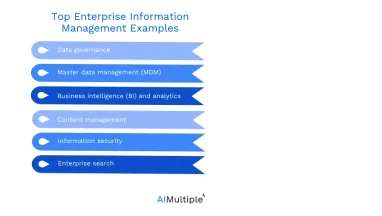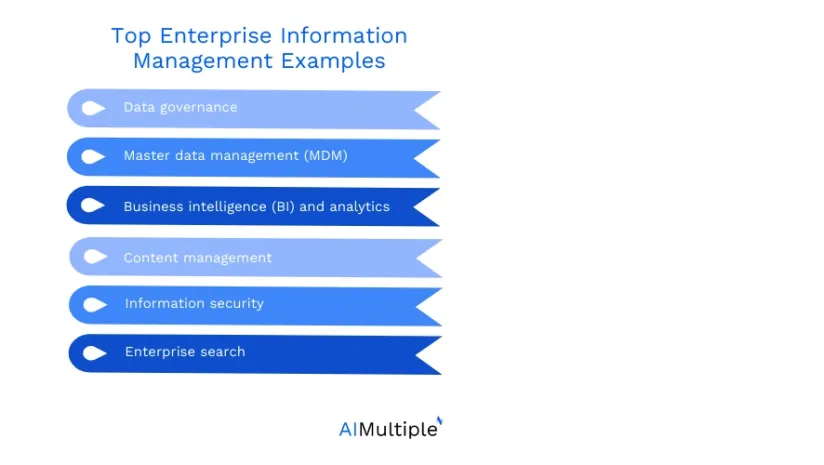Best 6 Enterprise Information Management Examples in 2024


According to big data statistics, the global data volume is expected to reach 149 zettabytes by 2045. But given the growing amount of data, not everyone is taking full advantage of its analytics potential. Estimatedly, 60-70% of enterprise data is not analyzed and not transformed into valuable information.
Enterprise information management (EIM) refers to organizations’ strategies and technologies to manage and leverage their information assets. EIM helps companies:
- Manage information
- Leverage big data generated
- Understand and transform the enterprise platforms
- Automate and improve business processes
- Improve efficiency.
Despite EIM’s advantages, only 48% of businesses have a clear EIM strategy. One reason could be business leaders and analysts lacking familiarity with EIM. Therefore, we will provide 6 enterprise information management examples to help organizations develop better EIM strategies.
1. Data governance
Data governance is the practice of managing and maintaining data in an organization.
Data governance helps organizations:
- Ensure compliance
- Standardize data systems, standards and procedures
- Improve data quality
- Decrease data management costs
- Reduce errors
- Enhance operational efficiency.
Data governance is a key aspect of information management since it involves:
Standardizing data definitions
Data governance can help to establish a common understanding of key data concepts and definitions across the organization. This ensures that everyone uses the same terminology and data structures, which helps eliminate confusion and inconsistencies in data management.
Defining data ownership and stewardship
Data governance can help define clear roles and responsibilities for managing data across the organization. This includes assigning data owners and stewards responsible for ensuring that data is accurate, complete, and secure.
Establishing data quality standards
Data governance can help develop standards that define how data should be assessed, measured, and maintained. This ensures that the organization’s data is reliable and trustworthy, which supports effective decision-making.
Ensuring compliance with regulations and standards
Data governance can help to ensure that the organization’s data is managed in compliance with relevant rules and standards, such as data privacy laws. This helps to reduce the organization’s risk of non-compliance and associated penalties.
2. Master data management (MDM)
Master data is the core data which underlies business objects such as customers, locations or products. Master data management collects data from different systems to create a well-defined single master record for all departments. This helps ensure that everyone in the organization utilizes the same data and eliminates inconsistencies and errors.
Master data management and information management are closely related since MDM provides the foundation for IM initiatives. Without effective MDM, the underlying data may be inconsistent, inaccurate or unreliable, reducing the successful implementation of information management.
For example, an organization has multiple departments responsible for managing customer data sets, such as contact information, purchase history, and preferences. Each department uses its data management system to store and maintain this data, resulting in redundant, inconsistent, and inaccurate customer data across the organization.
Discover top master data management applications
3. Business intelligence (BI) and analytics
Business intelligence (BI) and analytics involve using data to gain insights into business operations for data-driven decision making. BI and analytics include collecting, analyzing, and visualizing data from multiple sources to identify trends, patterns, and opportunities.
Both BI and Analytics require effective information management practices to be successful. Information management guarantees that data used for BI and analytics are accurate and reliable.
For instance, an organization wants to apply BI and analytics to their data registered in customer relationship management (CRM), enterprise resource planning (ERP), and supply chain management (SCM) systems. This organization can bring data from various systems into a centralized data warehouse by applying information management systems. As a result, the organization can create dashboards, reports, and visualizations highlighting key insights and trends.
4. Content management
Content management involves managing unstructured data such as documents, images, and videos. Content management ensures easy access, search and usage for organizations’ content by organizing and storing content and providing search and retrieval capabilities.
Content is a key component of an organization’s information asset. Without effective content management, information assets would be inefficient.
For example, an organization can benefit from content management to categorize its content based on document type, department, or project. This way, data becomes easier to search, use and manage.
5. Information security
Information security protects sensitive data from unauthorized access, disclosure, and destruction. This includes implementing security controls such as encryption, access controls, and monitoring.
Information security and information management are closely related concepts since they are both about protecting and managing an organization’s information assets. In this respect, information security measures are critical components of information management.
Suppose a firm aims to use its sensitive data stored in a database (e.g. personal, financial, and confidential business information) while protecting it from unauthorized access, use, and disclosure. The company can implement:
- Access controls to ensure that only authorized users have access to the data.
- Encryption to prevent data breaches,
- Information management to standardize data formats and establish clear data ownership and stewardship.
6. Enterprise search
Enterprise search helps employees find data from one or multiple databases in a single search query. The searched data can be in any format, from anywhere inside the company, such as:
- In databases
- Document management systems
- E-mail servers
- Physical documents
Enterprise search engines use search technologies such as natural language processing, machine learning, and semantic analysis to improve search accuracy and relevance.
Information management practices are essential to ensure the effectiveness of enterprise search. Information management provides relevant information in the search index so that search results are accurate and complete.
For example, imagine an organization storing a large amount of unstructured data across multiple repositories, such as file shares, email systems, and SharePoint sites. The data includes documents, emails, and other files related to different projects, departments, and teams. If users try to search through these multiple repositories, they would have wasted time and effort.
But with effective information management, the organization can ensure easy, accurate and complete search in its enterprise search system. As a result, they can boost productivity, efficiency, and better decision-making.
Further reading
Discover more on knowledge management by checking out:


Comments
Your email address will not be published. All fields are required.